To determine the electron configuration for any particular atom, we can “build” the structures in the order of atomic numbers. Beginning with hydrogen, and continuing across the periods of the periodic table, we add one proton at a time to the nucleus and one electron to the proper subshell until we have described the electron configurations of all the elements. We call this procedure the Aufbau principle, which comes from the German word Aufbau, meaning “to build up”. Each added electron occupies the subshell of lowest energy available (in the order shown Figure 4 in the previous section).
The Pauli exclusion principle limits each orbital to just 2 electrons per orbital (discussed here). Electrons fill lower-energy subshells before moving to higher-energy ones. Since the arrangement of the periodic table is based on the electron configurations, most use the periodic table depicted below for determining the electron configuration. The filling order simply begins at hydrogen and includes each subshell as you proceed in increasing Z order. For example, after filling the 3p block up to Ar, we see the orbital will be 4s (K, Ca), followed by the 3d orbitals.
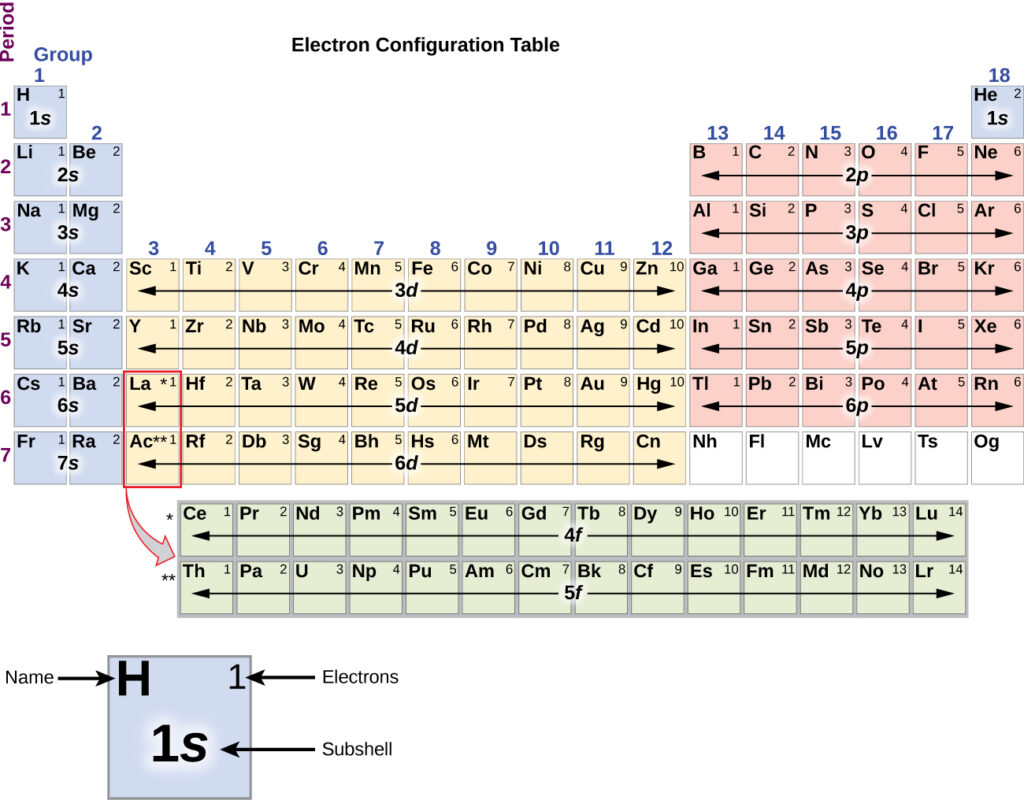
The older method for remembering the filling order shown below. If not drawn correctly from memory one can fill in the orbitals in an incorrect order. This is why the periodic table is usually the preferred route for referencing the filling order.
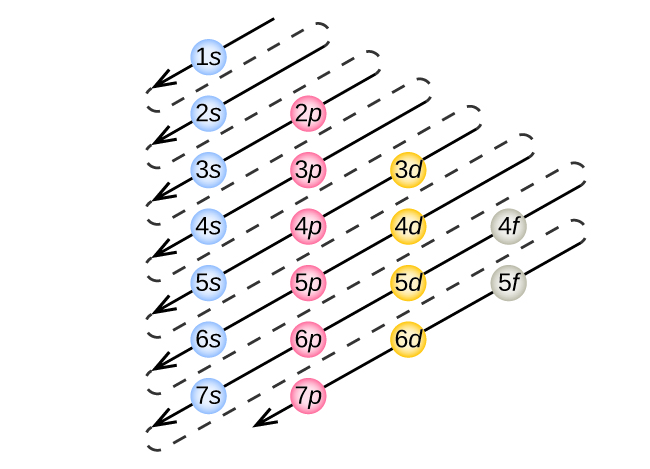
Electron configurations and orbital box diagrams
We will now construct the ground-state electron configuration for a selection of atoms in the first and second periods. Next, we will create the corresponding orbital box diagram (also called orbital diagrams) for these atoms. Orbital box diagrams are pictorial representations of the electron configuration, showing the individual orbitals and the pairing arrangement of electrons. We start with a single hydrogen atom (atomic number 1), which consists of one proton and one electron. Referring to the filling orders above, we would expect to find the electron in the 1s orbital. By convention, electron that spin with the external magnetic field (spinning up, ↑, ms=+$\frac{1}{2}$) are usually filled first. The electron configuration and the orbital diagram are:
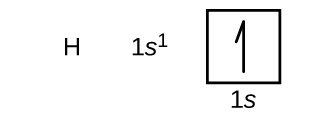
Following hydrogen is the noble gas helium, which has an atomic number of 2. The helium atom contains two protons and two electrons. The first electron has the same four quantum numbers as the hydrogen atom electron (n = 1, l = 0, ml = 0, ms= +$\frac{1}{2}$). The second electron also goes into the 1s orbital and fills that orbital with the opposite spin (against the external magnetic field, spinning down, ↓, ms= -$\frac{1}{2}$).
This is in accord with the Pauli exclusion principle. The principle states: No two electrons in the same atom can have the same spin in the same orbital. It also states that no two electrons can have the same set of four quantum numbers. For orbital box diagrams, this means two arrows go in each box, representing two electrons in each orbital. The arrows must point in opposite directions (representing paired spins). The electron configuration and orbital box diagram of helium are:
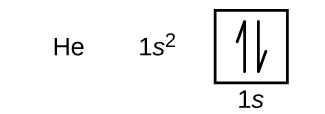
The n = 1 shell is completely filled in a helium atom.
The next atom is the alkali metal lithium with an atomic number of 3. The first two electrons in lithium fill the 1s orbital and have the same sets of four quantum numbers as the two electrons in helium. The remaining electron must occupy the orbital of next lowest energy, the 2s orbital. Thus, the electron configuration and orbital diagram of lithium are:

An atom of the alkaline earth metal beryllium, with an atomic number of 4, contains four protons in its nucleus. It also has four electrons surrounding said nucleus. The fourth electron fills the remaining space in the 2s orbital.

An atom of boron (atomic number 5) contains five electrons. The n = 1 shell holds with two electrons and three electrons will occupy the n = 2 shell. Any s subshell can contain only two electrons. Therefore, the fifth electron will occupy the next energy level, which will be a 2p orbital. There are three degenerate 2p orbitals (ml = −1, 0, +1). The electron can occupy any one of these p orbitals. Degenerate means same energy. When drawing orbital diagrams, we include empty boxes to depict any empty orbitals in the same subshell.
These boxes show the orbitals that we are filling:

Carbon (atomic number 6) has six electrons. Four of them fill the 1s and 2s orbitals. The remaining two electrons occupy the 2p subshell. We now have a choice of filling one of the 2p orbitals and pairing the electrons. Alternatively, we can leave the electrons unpaired in two different, but degenerate, p orbitals. Hund’s rule states that orbital fill to maximize the number of unpaired electrons in degenerate orbitals. This results in the lowest energy configuration for the atom.
Thus, the two electrons in the carbon 2p orbitals have identical n, l, and ms quantum numbers. They differ in their ml quantum number (in accord with the Pauli exclusion principle).
eThe electron configuration and orbital diagram for carbon are:

Nitrogen (atomic number 7) fills the 1s and 2s subshells and has one electron in each of the three 2p orbitals, in accordance with Hund’s rule. These three electrons have unpaired spins. Oxygen (atomic number 8) has a pair of electrons in any one of the 2p orbitals (the electrons have opposite spins) and a single electron in each of the other two. Fluorine (atomic number 9) has only one 2p orbital containing an unpaired electron. The noble gas neon (atomic number 10) has all its electrons paired, with all of the orbitals in the n = 1 and the n = 2 shells filled. The electron configurations and orbital diagrams of these four elements are:
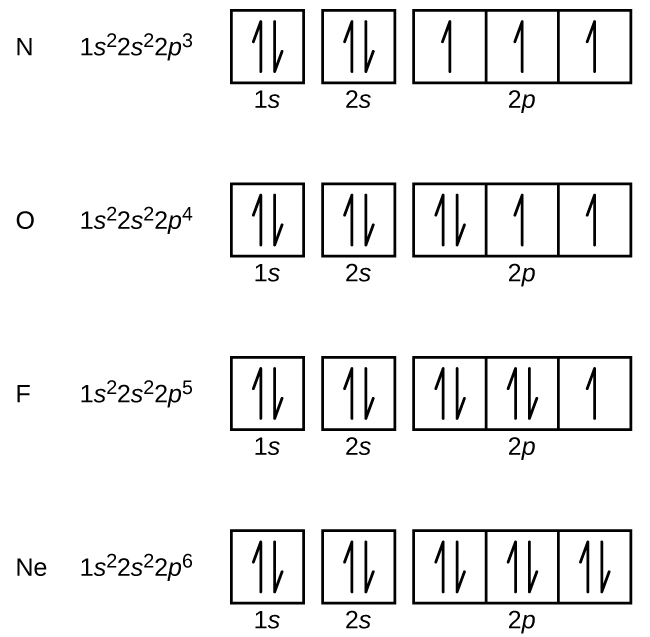
The alkali metal sodium (atomic number 11) has one more electron than the neon atom. This electron must go into the lowest-energy subshell available, the 3s orbital, giving a 1s22s22p63s1 configuration. valence electrons occupy the outermost shell orbital(s) (highest value of n), while core electrons fill the inner shell orbitals. Since the core electron shells correspond to noble gas electron configurations, we can abbreviate electron configurations. We do this by writing the noble gas that matches the core electron configuration, along with the valence electrons in a condensed format. For our sodium example, the symbol [Ne] represents core electrons, (1s22s22p6). So our abbreviated or condensed configuration (also called shorthand configuration) is [Ne]3s1.

The abbreviated configuration of lithium can be represented as [He]2s1, where [He] represents the helium atom’s configuration, matching the filled inner shell of lithium. Writing the configurations in this way emphasizes the similarity of the configurations of lithium and sodium. Both atoms, which are in the alkali metal family, have only one electron in a valence s subshell outside a filled set of inner shells. Li:[ He ]2s1Na:[ Ne ]3s1Li:[ He ]2s1Na:[ Ne ]3s1
The alkaline earth metal magnesium (atomic number 12), with its 12 electrons in a [Ne]3s2 configuration, is analogous to its family member beryllium, [He]2s2. Both atoms have a filled s subshell outside their filled inner shells. Aluminum (atomic number 13), with 13 electrons and the electron configuration [Ne]3s23p1, is analogous to its family member boron, [He]2s22p1.
The electron configurations of silicon (14 electrons), phosphorus (15 electrons), sulfur (16 electrons), chlorine (17 electrons), and argon (18 electrons) are analogous in the electron configurations of their outer shells to their corresponding family members carbon, nitrogen, oxygen, fluorine, and neon. The principal quantum number of the outer shell of the heavier elements has increased by one to n = 3. The periodic table below shows the lowest energy, or ground-state, electron configuration for these elements. It also includes the configurations of each of the known elements.
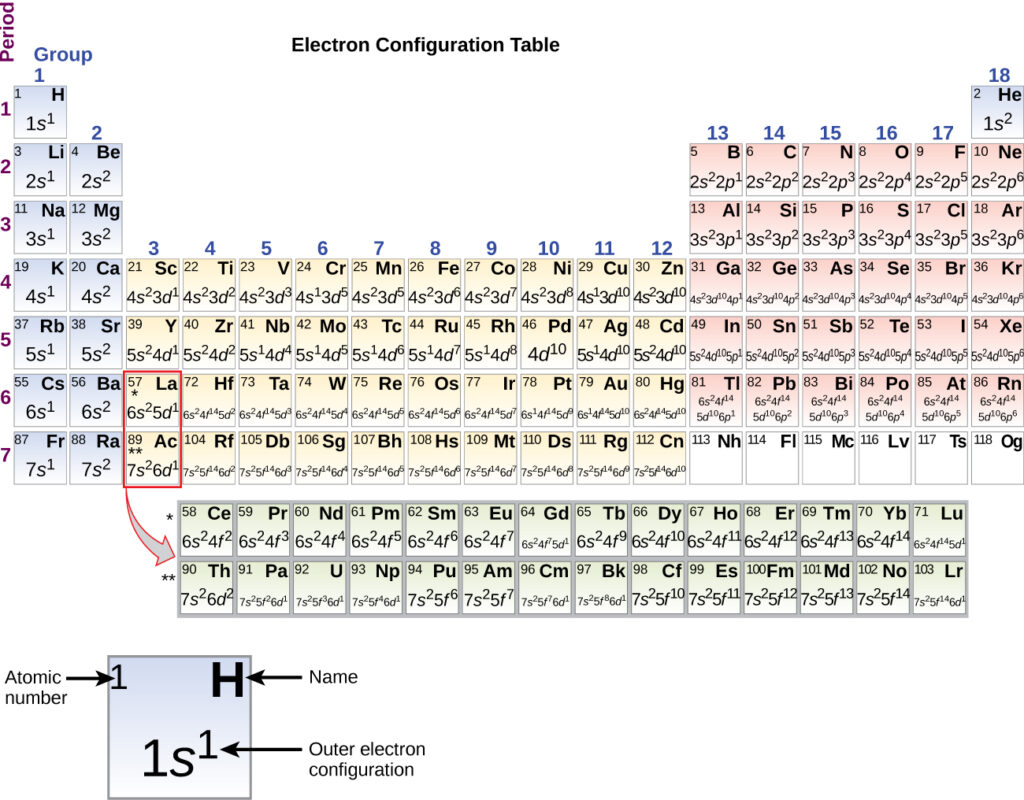
When we come to the next element in the periodic table, the alkali metal potassium (atomic number 19), we might expect that we would begin to add electrons to the 3d subshell. However, all available chemical and physical evidence shows that potassium is like lithium and sodium, adds the next electron to the 4s level, not the 3d level.
As discussed previously, the 3d orbital with no radial nodes is higher in energy because it is less penetrating and more shielded from the nucleus than the 4s, which has three radial nodes. Thus, potassium has an electron configuration of [Ar]4s1. Hence, potassium corresponds to Li and Na in its valence shell configuration. The next electron is added to complete the 4s subshell and calcium has an electron configuration of [Ar]4s2. This gives calcium an outer-shell electron configuration corresponding to that of beryllium and magnesium.
Starting with the transition metal scandium (atomic number 21), we add electrons successively to the 3d subshell. This subshell is filled to its capacity with 10 electrons (remember that for l = 2 [d orbitals], there are 2l + 1 = 5 values of ml, meaning that there are five d orbitals that have a combined capacity of 10 electrons). The 4p subshell fills next. Note for three series of elements – scandium (Sc) through copper (Cu), yttrium (Y) through silver (Ag), and lutetium (Lu) through gold (Au). We add a total of 10 d electrons to the previous (n-1) shell, increasin it from 8 to 18 electrons.
For two series – lanthanum (La) through lutetium (Lu) and actinium (Ac) through lawrencium (Lr) – we succesfully add 14 f electrons. These f electrons (l = 3, 2l + 1 = 7 ml values; thus, seven orbitals with a combined capacity of 14 electrons) increase the (n – 2) shell from 18 electrons to a total of 32 electrons.
Quantum Numbers and Electron Configurations
What is the electron configuration and orbital box diagram for a phosphorus atom? What are the four quantum number for the last added electrons?
Solution
The atomic number of phosphorus is 15. Thus, a phosphorus atom contains 15 electrons. The order of filling of the energy levels is 1s, 2s, 2p, 3s, 3p, 4s, . . . The 15 electrons of the phosphorus atom will fill up to the 3p orbital, which will contain three electrons:

The last electron added is a 3p electron. Therefore, n = 3 and, for a p-type orbital, l = 1. The ml value could be –1, 0, or +1. The three p orbitals are degenerate, so any of these ml values is correct. For unpaired electrons, convention assigns the value of +12+12
for the spin quantum number; thus, ms=+12.ms=+12.
Check Your Learning
Identify the atoms from the electron configurations given:
(a) [Ar]4s23d5
(b) [Kr]5s24d105p6 Answer:
(a) Mn (b) Xe
The periodic table can be a powerful tool in predicting the electron configuration of an element. However, we do find exceptions to the order of filling of orbitals that are shown in the periodic table and energy listings in Figures 1 & 2. For instance, the electron configurations (shown in Figure 11) of the transition metals chromium (Cr; atomic number 24) and copper (Cu; atomic number 29), among others, are not those we would expect. In general, such exceptions involve subshells with very similar energy, and small effects can lead to changes in the order of filling.
In the case of Cr and Cu, we find that half-filled and completely filled subshells apparently represent conditions of preferred stability. This stability is such that an electron shifts from the 4s into the 3d orbital to gain the extra stability of a half-filled 3d subshell (in Cr) or a filled 3d subshell (in Cu).
Other exceptions can also occur. Click here to learn more!
Other exceptions also occur. For example, niobium (Nb, atomic number 41) is predicted to have the electron configuration [Kr]5s24d3. Experimentally, we observe that its ground-state electron configuration is actually [Kr]5s14d4. We can rationalize this observation by saying that the electron–electron repulsions experienced by pairing the electrons in the 5s orbital are larger than the gap in energy between the 5s and 4d orbitals.
There is no simple method to predict the exceptions for atoms. This is because the where the magnitude of the repulsions between electrons outweight the small differences in energy between subshells.
Electron Configurations and the Periodic Table
Remember that scientist develop the periodic table based on the chemical behavior of the elements. This occured long before they understood their atomic structure. Now we can understand why the periodic table has its current arrangement. The arrangement puts elements whose atoms have the same number of valence electrons in the same group. The colored sections of Figure 11 show the three categories of elements classified by the orbitals being filled: main group, transition, and inner transition elements. These classifications determine which orbitals are counted in the valence shell, or highest energy level orbitals of an atom.
- Main group elements (sometimes called representative elements) are those where the last electron added enters an s or a p orbital in the outermost shell. These elements are shown in blue and red in Figure 11. This category includes all the nonmetallic elements, as well as many metals and the metalloids. The valence electrons for main group elements are those with the highest n level. For example, gallium (Ga, atomic number 31) has the electron configuration [Ar]4s23d104p1, which contains three valence electrons (underlined). The completely filled d orbitals count as core, not valence, electrons.
- Transition elements or transition metals. These are metallic elements in which the last electron added enters a d orbital. The valence electrons (those added after the last noble gas configuration) in these elements include the ns and (n – 1) d electrons. The official IUPAC definition of transition elements specifies those with partially filled d orbitals. Thus, the elements with completely filled orbitals (Zn, Cd, Hg, as well as Cu, Ag, and Au in Figure 11) are not technically transition elements. However, the term is frequently used to refer to the entire d block (colored yellow in Figure 11), and we will adopt this usage in this textbook.
- Inner transition elements are metallic elements in which the last electron added occupies an f orbital. They are shown in green in Figure 11. The valence shells of the inner transition elements consist of the (n – 2)f, the (n – 1)d, and the ns subshells. There are two inner transition series:
- The lanthanide series: lanthanide (La) through lutetium (Lu)
- The actinide series: actinide (Ac) through lawrencium (Lr)
We include lanthanum and actinium in the series naming because of their similarities to the other members of the series. Even though they are transition metals with no f electrons, their properties often align closely with those int he series.